Justo Garrán Moso
Justo Garrán Moso | |
|---|---|
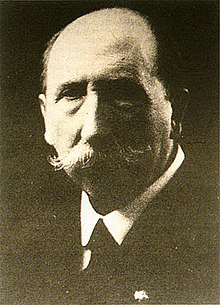 | |
| Born | Justo Garrán Moso[1] 1867 Olite, Spain |
| Died | 1942 Pamplona, Spain |
| Nationality | Spanish |
| Occupation | lawyer |
| Known for | politician |
| Political party | PSP, Carlism |
Justo Pastor Román Garrán Moso (1867–1942) was a Spanish Catholic lawyer, publisher and politician, related to Valladolid and Navarre. He owned and managed a local vallisoletano newspaper, Diario Regional (1908–1926). In terms of ideology he was closest to Traditionalism. In terms of politics Garrán approached various right-wing currents, in-between maurismo, Integrism, corporativist Christian Democracy, primoderiverismo and Francoism, yet he was most associated with Carlism. His career climaxed during two terms in the Cortes (1919–1920, 1923); he was also member of the primoderiverista quasi-parliament, Asamblea Nacional Consultiva (1928–1930). He served in the Navarrese self-government, Diputación Foral (1928–1930), and was member of the republican Tribunal de Garantías Constitucionales (1933–1936). Garrán was also the author of few theoretical treaties, dedicated to Church-state relations and to separate Basque-Navarrese legal establishments.
Family and youth
[edit]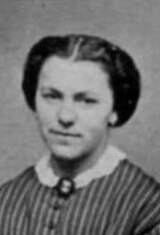
The Garráns have been for generations related to Valladolid. Justo's great-grandfather, Nemesio Garrán Martínez, was regidor of the city, where he represented "artes y oficios"; in the Napoleonic period he voiced against resistance and advocated loyalty to “rey D. José Napoleon I".[2] Justo's grandfather, Esteban Garrán Vitores (1797[3] -1865[4]), was "propietario fabricante de sombreros"[5] and in the 1830s also served as regidor.[6] Justo's father, Mauricio Garrán Román (1827–1898),[7] graduated as engineer; initially posted to Tarragona, he briefly worked as jefe of Obras Públicas in Pamplona and Burgos, until in the mid-1860s he assumed the same role in Barcelona. For some 10 years he was heavily involved in development of its harbor infrastructure and until today he is considered one of key people in its history.[8] In the mid-1880s he moved to Ministerio de Ultramar and then Ministerio de Fomento, in the Caminos, Canales y Puertos section;[9] he also published some works on engineering.[10]
During his service in Navarre, Garrán Román married Josefa María Micaela Moso Navarlaz (1831–1921)[11] from Olite. Her ancestors belonged to hidalguia related to Tafalla; the Navarlaz owned more land than the Moso.[12] Her father, Juan Moso Villanueva,[13] “tesorero de rentas”,[14] acquired prestigious status when following death of her mother he remarried with descendant to Conde de Espoz y Mina.[15] Mauricio Garrán Román and Micaela Moso Navarlaz will have 4 children; apart from Justo also Mauricio, María and Josefa.[16] In line with professional assignments of Mauricio the family soon moved to Barcelona, where the young Justo spent his childhood and adolescence; he obtained bachillerato in Ciudad Condal, before they moved to Madrid.[17] In the mid-1880s he enrolled in law at Universidad Central and was an excellent student.[18] Garrán Moso graduated in 1891, with his thesis titled La división de poderes. El poder moderador.[19] The same year he was admitted to Colegio de Abogados de Madrid.[20] He was initially employed in the law firm of Germán Gamazo[21] (in some sources "despacho Maura-Gamazo"[22]) before returning to Valladolid to open his own office.[23]
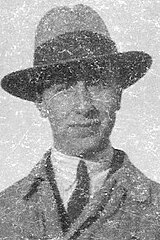
In 1900[24] Justo Garrán married a Pamplonesa, Catalina Moso Subiza (1870[25]-1925[26]). Both were fairly closely related as they had the same grandfather, Juan Moso Villanueva; Justo was his descendant from the first marriage, and Catalina from the second one.[27] Her father, II. Conde de Espoz y Mina, was a prestigious Navarrese aristocrat and served as diputado foral in the mid-1870s.[28] The couple settled in Valladolid, where Justo practiced and owned urban real estates, inherited from his father, though from his maternal ancestors he inherited also some rural estate in Olite. Justo and Catalina had 3 children, born between 1901 and 1912:[29] Mauricio, María and José Garrán Moso.[30] Both sons engaged in Carlism and served as requetés during the civil war.[31] José became a well-known Navarrese politician of early Francoism; he served as alcalde of Pamplona (1940–1941) and FET leader[32] and civil governor of Biscay (1941–1942).[33] None of Justo's grandchildren from Garrán Arraiza, Huarte Garrán and Garrán Sagarra families became a public figure.
Early public engagements (until 1919)
[edit]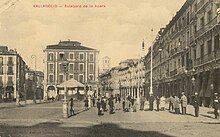
Garrán's ascendants were associated with Liberalism. His paternal grandfather commanded liberal militia during the First Carlist War,[34] while his father was “un alfonsino declarado”;[35] his maternal grandfather was related to the iconic liberal Espoz y Mina family.[36] However, the young Justo did not follow suit. Already during his academic period he co-signed letters which protested alleged anti-religious governmental policy and were published in the Integrist (1885)[37] or Catholic (1888)[38] papers. Following death of his father, Garrán burnt his liberal books.[39] In the 1890s he engaged in local Catholic organisations and emerged as their prominent member; in 1901 in name of Unión de Católicos de Valladolid he was signing various declarations.[40] In the 1903 elections he ran for the Cortes[41] as the Unión de Católicos candidate; he lost.[42] In 1905 an Integrist newspaper claimed he would run again, this time as a Carlist candidate;[43] it is not clear whether he lost or withdrew.
In the early 1900s Garrán engaged in a local daily flavored with Integrism, El Porvenir; at least since 1905 he was member of its “sociedad editora”[44] and at least since 1906 he was its director.[45] However, due to unspecified conflict within board he stepped down in 1907.[46] In 1908 and with his own money he set up a new daily, Diario Regional.[47] It adhered to intransigent Catholic line and formed part of so-called “buena prensa”; according to contemporary scholar it advanced clericalism.[48] Diario soon became a popular Valladolid newspaper; with the circulation of 5,000 it was second only to its main competitor, El Norte de Castilla, owned by a liberal political Santiago Alba.[49] Garrán did not manage his newspaper on the commercial basis; he envisaged it as part of a religious mission,[50] carefully vetted adverts in terms of morality and covered periodic debts with his own money.[51] It is not clear whether Diario supported any specific political current. Apparently some readers associated it with Traditionalism; in 1910 the Carlist jefé regional thought it necessary to declare Diario Regional an “enemigo nuestro”, called all Carlists to stop reading it and Carlist newspapers to stop reprinting its articles.[52]
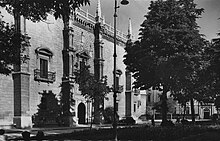
Having turned 40 Garrán was already a local prestigious vallisoletano figure. Since 1900 he was related to the local Universidad Literaria de Valladolid, first in Claustro de Doctores[53] but in 1914 he was nominated catedrático numerario de derecho mercantil.[54] He was in executive of numerous charity initiatives (like Patronado de Niños Desamparados de Valladolid),[55] lay Catholic organisations (he served as secretary of Apostolado de Oración in Valladolid)[56] and other associations (e.g. he remained active in the local branch of Liga Anti-duelista).[57] As owner of numerous plots in the city,[58] since 1907 he served also as vicepresidente of Asociación de Propietarios de Fincas Urbanas;[59] in 1915 he entered the board of Banco Castellano.[60] In the early 1910s he co-founded and animated the local branch of Acción Social Popular,[61] though it was only in 1916 that he entered its Junta directiva.[62] In 1918 he purchased El Porvenir[63] and merged it with Diario Regional.[64]
Cortes deputy (1919-1923)
[edit]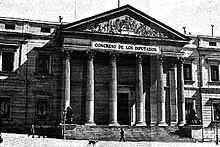
During the 1919 general elections Garrán fielded his candidature for Congress of Deputies, yet he was not formally associated with any political grouping. Some papers referred to him as to a “maurista”,[65] member of a splinter right-wing faction of the decomposing Conservative Party, led by Antonio Maura. Others presented him as a candidate “de Acción Social Católica”.[66] However, he was most frequently presented as “católico independiente”[67] or simply as a Catholic politician.[68] Garrán fared far worse than the maurista candidate Julio Pimentel and the liberal one Santiago Alba, but he narrowly managed to defeat another liberal competitor, Antonio Royo Villanova;[69] he gathered 8.907 votes out of 22.491 votes in total.[70] His tenure lasted slightly longer than a year, as the chamber was dissolved in 1920. During this period he barely made himself known, not a single time mentioned in the press.[71]
Prior to the 1920 elections Garrán was expected to renew his bid from Valladolid,[72] though according to some titles as “católico regionalista” he would rather run for the senate.[73] Eventually he did not compete for the lower chamber, while it is not clear whether he took part in behind-the-scenes negotiations about the upper one. In the early 1920s he engaged in various initiatives calibrated as efforts to defuse social conflict by means of Christian teaching. He lectured in Casa Social Católica,[74] spoke at “mitin social popular”,[75] delivered address at the rally of ACNDP in Madrid.[76] In 1922 he was among co-founders of Partido Social Popular,[77] yet he did not assume any formal role in the party. However, according to some scholars in the early 1920s he rather moved from nascent Christian Democratic format to corporativismo.[78] In 1923 he published[79] Apuntes histórico críticos sobre las regalías de la corona,[80] a treaty on relations between the state and the Church;[81] the message was that the 1851 concordat was outdated and a new one was needed.[82]
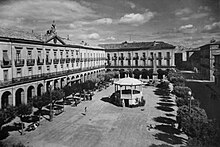
In the last general elections held during the restoration era, in 1923, Garrán again appeared as “católico independente”,[83] though some thought him "afín a mauristas".[84] This time he decided to compete not in Valladolid, but in the Navarrese Tafalla, the electoral district which included his native Olite.[85] His candidature was floated by the local Integrist politician José Sánchez Marco, and got endorsed by the Integrists.[86] He ran under the "Dios, Patria y Fueros" motto[87] and declared himself defender of Navarrese foralism. Initially he was pitted against a Carlist, Esteban Martínez-Velez;[88] eventually the latter admitted that Garrán was “natural del país” and “católico-fuerista”, and withdrew in his favor. Also the conservative datista candidate Conde del Vado withdrew in favor of Garran.[89] Eventually he competed against a liberal garciaprietista candidate Pedro Arza Uriz and emerged decisively victorious,[90] having gathered 5.800 votes.[91] This time his tenure in the Cortes was even shorter; he took the oath in May, but already in September the Primo de Rivera coup terminated the period of liberal democracy, resulting in dissolution of the parliament.
Primoderiverista (1923-1931)
[edit]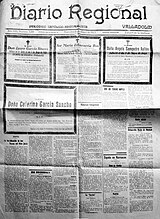
Garrán with no reservations voiced in support of the dictatorship. In 1924 he was among co-founders of the Valladolid branch of Unión Patriótica (UP), the primoderiverista quasi-party.[92] He took part in numerous local propaganda rallies which backed the Directorio, and as owner of Diario Regional he unequivocally promoted the new regime.[93] However, since he kept running the newspaper as part of an apostolic pursuit, it was generating increasing losses that Garrán found more and more difficult to absorb. Eventually, following 18 years he withdrew from the project. In 1926 (some sources claim that in 1927[94]) he sold the business to a newly set company, Diario Regional S.A.; its ownership was vastly dispersed among numerous members of local bourgeoisie; he retained the largest share of 4.8%.[95]
In the mid-1920s Garrán renewed his relations with Navarre. In 1924 he published an article[96] which advocated a Navarrese UP policy as not only maintenance of separate local establishments, but also restoration of the lost ones and creating new bodies; he called for a corporative regional parliament named Junta General del Reino. Present-day scholar considers the project “en la órbita del foralismo tradicionalista” and notes that it surely must have clashed with centralizing vision of the Directorio, which led to conflicts between Madrid and Pamplona over the new Estatuto Municipal and so-called cupo.[97] However, this did not lead to deterioration of Garrán's position within the regime structures. The Navarrese UP branch launched his candidature for Diputación Foral, the local self-government, at the time its members appointed by the Ministry of Interior. He received support from 28 local ayuntamientos[98] and in 1928 he was nominated as representative of the Tafalla merindad.[99] His first step in the office was wiring the message of support to Primo.[100] The same year the Diputación delegated him to Asamblea Nacional Consultiva, the quasi-parliament set by the regime.[101]
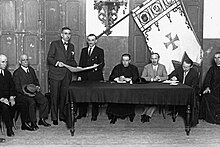
Though he continued with Valladolid-related roles in Asociación de Propietarios de Fincas Urbanas and Banco Castellano,[103] in the late 1920s Garrán got increasingly engaged also in the Navarrese business. In 1929 he ascended to presidency of Federación Católico-Social de Navarra (FCSN),[104] a powerful regional agricultural organisation, controlled by mid-size and large terratenientes; it grouped 99 Sindicatos Agrícolas or Cajas Rurales and had 13,291 members.[105] He also lobbied for setup of a landholders’ organization, which would materialize in early 1931 as Asociación de Propietarios Terratenientes de Navarra,[106] and entered the executive of Sociedad de Socorros Mutuos "La Conciliación".[107] The fall of Primo marked a turn for the worse; in 1930 he lost the seat both in Diputación[108] and in Asamblea;[109] local press criticised Garrán for his support for the dictatorship.[110] His presidency in FCSN expired either in 1930[111] or in 1931.[112] In anticipation of forthcoming general elections, in February 1931 he was listed as one of prospective Pamplonese candidates (as “católico independiente”) to the Cortes.[113]
Carlist (1931-1936)
[edit]
In the newly established Second Republic initially Garrán was busy engaged against the secular governmental policy. In 1931 he signed numerous protest letters, either on his own behalf – e.g. in relation to would-be expulsion of religious orders,[114] or in name of La Conciliación;[115] the same year he joined Asociación Defensora de Religiosos Vasco-Navarros.[116] At the time a plan for a Basque-Navarrese autonomous region was widely discussed. Its first version was drafted by Socieded de Estudios Vascos, the organisation where he hold membership;[117] Garrán supported it and its modified version, named "Estatuto de Estella".[118] However, once the statute has been rejected by the republican Cortes and appointed comisiones gestoras came out with a new draft, he firmly spoke against it; in his view this "estatuto nacionalista"[119] promoted separatism and stripped the would-be autonomy of defensive measures versus the Madrid-advanced secularization;[120] in 1932 Navarre opted out of the scheme.
In the early 1930s Garrán neared Carlism. In May 1932 he took part in a Valladolid meeting, which formally set up a regional branch of the united Carlist organisation, Comunión Tradicionalista.[121] Later he presided over Carlist rallies in the city, e.g. in the local theatre[122] or opening new premises.[123] In 1933 he entered Consejo de Administración of Editorial Tradicionalista S.A., the Carlist publishing house.[124] The same year Junta Regional Tradicionalista de Pamplona nominated him as candidate to Tribunal de Garantías Constitucionales,[125] where he was elected from Navarre.[126] In 1934 he gave lectures on Carlist doctrine, printed in the party newspaper El Pensamiento Navarro,[127] served as presidente honorario of Centro Tradicionalista in Valladolid,[128] and took part in a broadly-designed scheme of Traditionalist lectures across the country; he was assigned to a section dedicated to “orientación general”.[129] However, according to some scholars he merely “se integró informalmente en el tradicionalismo”;[130] some maintain that Garrán “no se declaró nunca carlista”,[131] and some list him either among the Integrists[132] or as part of generic right.[133]
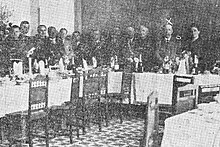
In 1935[135] Garrán published in Pamplona[136] a 300-page work, titled El Sistema Foral de Navarra y Provincias Vascongadas.[137] It was a historiographic and juridical treaty on separate Basque-Navarrese legal establishments. Tailored as a response to Basque nationalist designs,[138] stained by “los principios radicales y marxistas”,[139] it advanced the vision of two separate paths. In case of Vasconia, Garrán advocated Junta General and Diputacion Foral for every province and the regional Consejo Vascongado, with sort of auxiliary role and minor legislative powers; the proposal was entirely incompatible with the project of Basque autonomy, at the time processed by the parliament. In case of Navarre, Garrán recommended re-establishment of Consejo Foral Administrativo as the regional executive. By scholars the scheme is described as “en la órbita del tradicionalismo”.[140] The author called all Basques and Carlists to co-operate to bring the scheme to life.[141] The work barely made an impact; though noticed in Navarrese papers, it was ignored among the Basque nationalists and the Madrid legislators.
Last years (1936 and afterwards)
[edit]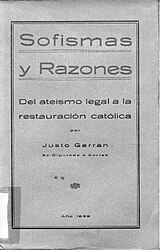
During the July Coup Garrán resided in Valladolid, the city easily seized by the rebels. According to his daughter, during the mayhem that followed he sheltered numerous left-wingers in his house.[142] In August 1936 Junta Central Carlista de Guerra de Navarre, the regional wartime Carlist executive, nominated him to Comisión para la Reintegración Foral.[143] The task of this body was to work out the scheme of Basque-Navarrese status in the new Spain, yet there is no further information either on its works or on Garrán's role. In February 1937 general Dávila nominated him president of Tribunal Tutelar de Menores de Pamplona,[144] a Navarrese corrective institution for minors; he would hold this position until death.[145] In August 1937 a “Justo Garrán y Moso” was officially listed as alférez provisional.[146] There is no further information on his public activities, either in politics or in business, except few isolated press notes on his taking part in Carlism-flavored cultural events.[147]
In 1939 Garrán published book, Sofismas y Razones. Del ateísmo legal a la restauración católica.[148] The 280-page pamphlet, approved by ecclesiastic censhorship, was continuation of his 1923 work, Apuntes histórico críticos sobre las regalías de la corona, though this time the author focused mostly on culture and education in relations between the state and the Church. Formally fully aligned with propaganda of the emerging Francoist regime, the book contained numerous references to “glorioso Movimiento Nacional”[149] and “el illustre Caudillo”.[150] In terms of content, it was a call to do away with the 19th-century concordat and with all the secular republican legislation and to “reanudar la observancia de las festividades religiosas, dignificar el matrimonio cristiano y sanear con toda eficacia la enseñanza”.[151] In terms of detailed solutions Garrán refrained from any suggestions, though the chapter La solución futura advanced a vision of friendly partnership between the state and the Church.[152] In Falangist press the work was greeted with a lukewarm welcome as well-researched, but generally outdated.[153]
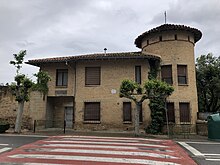
At the turn of the decades Garrán withdrew into privacy, and it was his son José who briefly emerged as holder of high administrative positions in Navarre and Biscay. Justo limited himself to publishing few pieces in a Carlist periodical La Avalancha;[154] he was last recorded in public discourse in 1941, as the author of an article on so-called ley paccionada,[155] a Navarre-related regulation introduced 100 years earlier.[156] Until death he presided over few local Catholic organisations.[157] Garrán's passing away was not acknowledged in nationwide press; local Pamplona and Valladolid titles published rather brief obituary articles.[158] Later his name went into almost total oblivion; except a large 1957 article in Diario Regional, which hailed Garrán as the founder of the daily,[159] he disappeared from public discourse. Today his pamphlets might appear in bibliographic listings in works on fuerismo[160] or state-Church[161] relations; he earned very brief biographical pieces in few online encyclopedias[162] and in one historiographic dictionary.[163]
See also
[edit]Footnotes
[edit]- ^ in some works his segundo apellido is spelled "Mosso", see e.g. Manuel Revuelta González, S.J., La Compañía de Jesus en la España Contemporánea, vol. II, Madrid 1991, ISBN 8487840078, p. 866, or Pilar León Sanz, Identidad e integración social: análisis de la sociabilidad en una sociedad de socorros mutuos (1902-1933), [in:] Dynamis 35 (2015), p. 42. It might have appeared as "Mosso" also in contemporary press. However, official documents and his books feature "Moso"
- ^ in 1809 as regidor he co-signed a loyalist order, which claimed that "la resistencia armada es un acto quimérico, irracional, incivico y sórdido", and invited to stand by "su rey D. José Napoleon I", Jorge Sánchez Fernández, Valladolid durante la Guerra de la Indepndencia Española (1808-1814) [PhhD thesis Universidad de Valladolid], Valladolid 202, pp. 203-204
- ^ Justo Pastor Garran Moso entry, [in:] Geneaordonez service, available here
- ^ Boletin Oficial de la Provincia de Valladolid 04.12.66, available here
- ^ El Corresponsal 14.12.41, available here
- ^ Boletin Oficial de la Provincia de Valladolid 08.10.36, available here
- ^ Justo Pastor Garran Moso entry, [in:] Geneaordonez service, available here
- ^ compare e.g. The Port, the doorway to Barcelona, [in:] DerelicteBarcelona service, available here
- ^ Mauricio Garrán Román, [in:] Real Academia de la Historia service, available here
- ^ he wrote, among minor works, Comentario al pliego de condiciones generales aprobado por el Real decreto de 10 de julio de 1861 (Barcelona 1861), Tratado de la formación de los proyectos de carreteras (Madrid 1862), Memoria elevada a la Dirección General de Obras Públicas por el Ingeniero jefe de 1ª clase D... al cesar en el cargo de Director facultativo de las obras del Puerto de Barcelona (Barcelona 1881)
- ^ Josefa María Micaela Garrán Román entry, [in:] MyHeritage service, available here
- ^ near Tafalla, Olite, Olleta, Barasoain, and San Martin de Unx
- ^ Josefa Maria Michaela Moso Navarlaz, [in:] Geneaordonez service, available here
- ^ “Lo califican de ‘profesión’ ‘Tesorero de rentas’, mas evidentemente es un rico propietario con múltiples fincas y corralizas localizables en Olite”, Diario de Navarra 20.04.1987
- ^ following death of his wife María Navarlaz, Juan Moso re-married with Clementa Irure Espoz, the niece of Francisco Espoz y Mina; as the latter died childless she was the one who inherited the family possessions and the liberal heritage. However, during the second marriage Moso lived on estate of his first wife, in Olite, Pascual Tamburri Beriáin, Materiales para la reconstrucción del archivo de Francisco Espoz y Mina y sus herederos, [in:] Huarte de San Juan 8 (2001), pp. 107-126. One author claims that Garran's “madre era hermana del conde de Espoz y Mina”, see Pablo Pérez López, Católicos, política e información. Diario Regional de Valladolid, 1931-1980 [PhD thesis Universidad de Valladolid], Valladolid 1992, p. 39; this statement is incorrect
- ^ Mauricio Garran Roman, [in:] Geneaordonez service, available here
- ^ Recuerdo y homenaje a don Justo Garrán, fundador de Diario Regional, [in:] Diario Regional 17.11.56, available here
- ^ already as a 22-year-old, in 1888 he was allowed to deliver a lecture at Real Academia de Jurisprudencia, La Publicidad 26.02.88, available here. He spoke Catalan, French, English, German and Italian, and later subscribed to various newspapers in these languages, Pérez López 1992, p. 39
- ^ Garran Moso, Justo entry, [in:] Portal de Archivos Españoles service, available here
- ^ Garran Moso, Justo entry, [in:] Patrimonio documental del Ilustro Colegio de Abogados de Madrid, available here
- ^ Recuerdo y homenaje a don Justo Garrán, fundador de Diario Regional, [in:] Diario Regional 17.11.56, available here
- ^ Pérez López 1992, p. 39
- ^ in 1900 he was noted as "abogado y acaudalado propietario de Valladolid", El Eco de Navarra 04.09.00, available here
- ^ La Epoca 08.10.00, available here
- ^ Catalina Moso Subiza entry, [in:] Geni service, available here
- ^ Garrán Moso, Justo entry, [in:] Auñamendi Eusko Entziklopedia service, available here
- ^ Justo's mother, Josefa Maria Moso Navarlaz, was daughter to Juan Moso Villanueva and his first wife, Maria Navarlaz Navarro. Catalina's father, Juan Moso Irure, II. Conde de Espoz y Mina, was son to Juan Moso Villanueva and his second wife, Clementa Irure Espoz
- ^ Ángel García-Sanz Marcotegui, Políticos-empresarios liberales y compañías en la explotación del bosque del Irati (Navarra) a mediados del siglo XIX, [in:] Príncipe de Viana 65/232 (2004), p. 557
- ^ Justo Pastor Román Garrán Moso entry, [in:] Geni service, available here
- ^ Libertad 29.08.42, available here
- ^ for Jose see Maria Larraza Micheltorena, Alcaldes de Pamplona durante el franquismo: Un retrato de conjunto, [in:] Memoria y civilizacion 15 (2012), p. 235. For Mauricio (died in 1945) see Javier Ugarte Tellería, La nueva Covadonga insurgente: orígenes sociales y culturales de la sublevación de 1936 en Navarra y el País Vasco, Madrid 1998, ISBN 9788470305313, p. 476
- ^ Libertad 12.09.42, available here
- ^ Libertad 05.09.42, available here
- ^ El Correo Nacional 23.04.38, available here
- ^ Pérez López 1992, p. 39
- ^ his maternal grandmother's family were probably Carlists; a Martín Antonio Navarlaz from Berasoain fought in legitimist ranks during the First Carlist War, Ángel García-Sanz Marcotegui, Javier Ruiz Astiz, Militares carlistas navarros (1833-1849), Pamplona 2017, ISBN 9788497693226, p. 405
- ^ El Siglo Futuro 01.04.85, available here
- ^ La Unión Católica 16.11.88, available here
- ^ Pérez López 1992, p. 39
- ^ El Diario Catalan 28.07.01, available here
- ^ El Universo 27.03.03, available here
- ^ Boletín Oficial de la Provincia de Valladolid 29.04.03, available here
- ^ La Epoca 19.07.05, available here
- ^ Recuerdo y homenaje a don Justo Garrán, fundador de Diario Regional, [in:] Diario Regional 17.11.56, available here
- ^ Boletin de la Sociedad Catalana de Excursiones 37 (1906), available here
- ^ El Diario de Avila 01.03.07, available here
- ^ Santiago Revilla Ramos, Identidad política de El Norte de Castilla y Diario Regional a través de la problemática internacional de los primeros años 20 (1920-1923), [in:] José Manuel Aldea Celada, Paula Ortega Martínez, Iván Pérez Miranda, Mª de los Reyes de Soto García (eds.), Historia, identidad y alteridad. Actas del III Congreso Interdisciplinar de Jóvenes Historiadores, Salamanca 2012, ISBN 9788494021435, p. 577
- ^ Revilla Ramos 2012, p. 577
- ^ both periodicals were distributed across all Castile, Diario mostly by subscription, Norte by street sales and post. Diario over time grew from 4 to 6 pages, Revilla Ramos 2012, pp. 578-579
- ^ and “instrumento para formar la corriente de opinión católica vallisoletana”, Revilla Ramos 2012, p. 577
- ^ Pérez López 1992, p. 56
- ^ El Correo Español 08.04.10, available here
- ^ Boletín Oficial de la Provincia de Valladolid 10.01.10, available here
- ^ Revista general de enseñanza y bellas artes 15.05.14, available here
- ^ Memoria. Patronato de Niños Desamparados, Valladolid, available here
- ^ El Siglo Futuro 28.10.05, available here
- ^ El Lábaro 23.05.05, available here
- ^ Garrán was mentioned in the press as owner of numerous plots or estates, e.g. Calle Duque de la Victoria, see Boletín Oficial de la Provincia de Valladolid 22.04.08, available here, at Calle Maria de la Molina, see Boletín Oficial de la Provincia de Valladolid 23.05.10, available here, at Calle de Gamazo, see Boletín Oficial de la Provincia de Valladolid 08.05.15, available here, at Calle San Juan de Díos, see Boletín Oficial de la Provincia de Valladolid 02.01.19, available here, or at Calle de Santiago, which led to conflict over expropriation related to construction of access road, leading to Academia de Caballería, see Boletín Oficial de la Provincia de Valladolid 28.11.24, available here
- ^ Boletín Oficial de la Provincia de Valladolid 23.09.07, available here. Garran and his wife financed the construction of new Jesuit monastery at Calle Ruiz Hernandez, next to the church. It is not clear whether he also donated the plot, see Revuelta González 1991, p. 866
- ^ Revista general de enseñanza y bellas artes 15.05.14, available here
- ^ Correo de Mallorca 31.08.11, available here
- ^ Revista católica de cuestiones sociales 6 (1919), available here
- ^ La Acción 02.02.18, available here
- ^ Recuerdo y homenaje a don Justo Garrán, fundador de Diario Regional, [in:] Diario Regional 17.11.56, available here
- ^ La Epoca 19.05.19, available here
- ^ El Día 02.06.19, available here
- ^ see Garrán's 1919 ticket at the official Cortes service, available here
- ^ El Día 24.05.19, available here
- ^ El Castellano 03.06.19, available here
- ^ see the official Cortes service, available here
- ^ he was rather noted for his extra-parliamentarian lobbying, in 1920 related to irrigation works in Castile, Boletin del Instituto de Radiactividad 1920, available here
- ^ El Universo 30.10.20, available here
- ^ La Epoca 31.12.20, available here, Ejercito y Armada 01.01.21, available here
- ^ El Debate 21.01.18, available here
- ^ El Mundo 05.03.20, available here
- ^ La Epoca 03.03.20, available here
- ^ Pérez López 1992, p. 82
- ^ Pérez López 1992, p. 83
- ^ as "profesor de la Real de Jurisprudencia y Legislación de Madrid"
- ^ Justo Garrán y Moso, Apuntes histórico críticos sobre las regalías de la corona, Madrid 1923
- ^ the work available online at Biblioteca Digital Hispanica service here
- ^ Revista Mariana 12 (1923), available here
- ^ El Año Político 1923, available here
- ^ Angel García-Sanz Marcotegui, Elites económicas y políticas en la Restauración. La diversidad de las derechas navarras, [in:] Historia Contemporánea 23 (2001), p. 616
- ^ until then his only identified link with Olite and Tafalla, apart from personal relations and inheritance of maternal landholdings, was his co-ownership of La Electra Tafalla-Olite, a small power-generation company based on a hydro-installation on the Arga river in Andión, near Mendigorría. However, in the early 1920s the installation has been sold and it is not clear whether Garrán retained either shares or influence in the business, José María Jimeno Juro, Sociedad de Corralizas y Electra de Artajona. De la vida tradicional a la industrial, [in:] Gerónimo de Uztariz 16 (2000), p. 146
- ^ Fernando Mikelarena Peña, Las posturas de la derecha tradicionalista y conservadora Navarra entre 1929 y 1940 en relación con la reintegración foral, [in:] Historia Constitucional 22 (2021), p. 415
- ^ please note that "Dios, Patria y Fueros" was close to, yet significantly distinct from the Carlist "Dios, Patria, Fueros, Rey". Though Garran systematically displayed attachment to religious (Dios), patriotic (Patria) and foralist (Fueros) values, not a single case of him endorsing the Carlist dynastic claim has been identified
- ^ Garrán Moso, Justo entry, [in:] Auñamendi Eusko Entziklopedia service, available here
- ^ Jesus M. Fuente Langas, Los procesos electorales de 1923 en Navarra, [in:] Príncipe de Viana 15 (1993), p. 450
- ^ he got 5594 votes versus 3525 votes of Arza, Fuente Langas 1993, p. 450
- ^ see his 1923 ticket at the official Cortes service, available here
- ^ Pérez López 1992, p. 41. According to other authors, he was merely among the first ones who joined the party, Guillermo A. Pérez Sánchez, Pablo Pérez López, Ricardo M. Martin de la Guardia, Juan A. Cano García, Parlamentarios vallisoletanos en la segunda Restauración (1901-1923), [in:] Investigaciones históricas: Época moderna y contemporánea 15 (1995), p. 86
- ^ La Correspondencia Militar 27.06.24, available here
- ^ Revilla Ramos 2012, p. 581
- ^ Pérez López 1992, p. 61
- ^ in Diario de Navarra
- ^ Mikelarena Peña 2021, p. 416
- ^ Garrán Moso, Justo entry, [in:] Auñamendi Eusko Entziklopedia service, available here
- ^ Idoia Estornés Zubizarreta, La contrucción de una nacionalidad vasca. El Autonomismo de Eusko-Ikaskuntza (1918-1931), Donostia 1990, p. 193
- ^ Garrán Moso, Justo entry, [in:] Auñamendi Eusko Entziklopedia service, available here
- ^ Mikelarena Peña 2021, p. 415
- ^ according to the original capture, Garrán is standing second from left. However, the man in question appears to be in his 40s or 50s, while Garrán at the time was in his mid-60s. Perhaps he is the man sitting second from left
- ^ El Financiero 08.03.29, available here
- ^ La Rioja 01.10.29, available here. His predecessors were Luis Elio (1910-1912), Gabriel Zabaleta (1912-1916), Esteban Dean (1916-1924), and Javier Martínez de Morentín (1924-1929), most of them Carlists or related to Carlism, Javier María Pejenaute Goñi, Desarollo del cooperativismo agrario navarro desde le Federación a la Confederación (1910-1917), [in:] Principe de Viana 50/188 (1989), p. 679
- ^ Emilio Majuelo Gil, Ángel Pascual Bonis, Del catolicismo agrario al cooperativismo empresarial: setenta y cinco años de la Federación de Cooperativas navarras, 1910-1985, Pamplona 1991, ISBN 8474798949, p. 186
- ^ Mikelarena Peña 2021, p. 415, Garrán Moso, Justo entry, [in:] Auñamendi Eusko Entziklopedia service, available here
- ^ "La Conciliación" was intended as an organisation grouping both employers and employees, and was supposed to provide a platform for sorting out labor conflicts. However, in the early 1930s "ya habia perdido su capacidad arbitral y funcionaba como una sociedad de socorros mutuos", Javier Dronda Martínez, Con Cristo o contra Cristo. Religión y movilización antirepublicana en Navarra (1931-1936), Tafalla 2013, ISBN 9788415313311, pp. 160-161. See also León Sanz 2015, p. 422, and Pilar León Sanz, La Cooperativa de ‘La Conciliación’ (Pamplona, 1902-1936): una iniciativa social desarrollada por una Sociedad de Ayuda Mutua, [in:] Teresa Abelló et al. (eds.), Heréncies, Barcelona 2023, ISBN 9788409563050, pp. 43-54.
- ^ Mikelarena Peña 2021, p. 415
- ^ Mikelarena Peña 2021, pp. 415-416
- ^ the case of La Voz de Navarra, see Garrán Moso, Justo entry, [in:] Auñamendi Eusko Entziklopedia service, available here
- ^ replaced by Esteban Ezcurra, Emilio Majuelo Gil, Ángel Pascual Bonis, Del catolicismo agrario al cooperativismo empresarial: setenta y cinco años de la Federación de Cooperativas navarras, 1910-1985, Madrid 1991, ISBN 8474798949, pp. 474-475
- ^ Mikelarena Peña 2021, p. 415
- ^ Ahora 13.02.31, available here
- ^ La Correspondencia Militar 03.06.21, available here, also El Siglo Futuro 09.09.31, available here
- ^ Estornés Zubizarreta 1990, p. 448
- ^ La Voz de Navarra 27.09.31, available here, also Dronda Martínez 2013, p. 143
- ^ Idioia Estornés Zubizarreta, La Sociedad de Estudios Vascos. Aportación de Eusko Ikaskuntza a la Cultura Vasca, Donostia 1983, ISBN 848624000X, p. 60
- ^ Estornés Zubizarreta 1990, p. 423
- ^ La Nacion 25.10.32, available here
- ^ “Garrán apoyó el Estatuto Vasco-Navarro en sus versiones de Estella o de las Gestoras enmendado para conformar un espacio autónomo católico .... El mismo 19 de junio de 1932, día de la Asamblea de representantes municipales en la que se iba a debatir, se posicionó radicalemente en contra del Estatuto vasconavarro”, Mikelarena Peña 2021, p. 416
- ^ Pérez López 1992, p. 156
- ^ El Castellano 27.02.33, available here
- ^ El Siglo Futuro 19.03.34, available here
- ^ El Siglo Futuro 12.12.33, available here
- ^ La Nacion 28.08.33, available here
- ^ together with Pradera they outclassed other candidates, Garrán Moso, Justo entry, [in:] Auñamendi Eusko Entziklopedia service, available here. Pradera was elected as vocal, and Garran as suplente, Dronda Martinez 2013, p. 355. Garrán did not play any meaningful role in the Tribunal. In November 1933 as vocal suplementario he was to inspect together with Pradera 2 cases related to Navarre, but he is not listed as the author of pronouncement in any of these questions. His only intervention is not related to constitutonal questions; in September 1935 he objected to spending 215,000 pesetas on renovation of the Tribunal building, since it was not the property of the Tribunal. In the volume, which documents proceedings of the Tribunal, Garrán is mentioned 4 times (as “D. Justo Garrán Monos”); in comparison, another member elected from Navarre, Pradera, is mentioned 463 times, see José Urosa Sánchez, Enrique San Miguel Pérez, Ignacio Ruiz Rodríguez, Francisco Marhuenda García (eds.), El Tribunal de Garantías Constitucionales de la II República. Colección Documental, Madrid 1999, ISBN 8445117149, pp. 71, 76, 79, 398
- ^ Mikelarena Peña 2021, p. 415
- ^ El Siglo Futuro 22.05.34, available here
- ^ with Rodezno, Bilbao, Larramendi, Diaz Aguado, Requejo, and Sivatte, El Siglo Futuro 29.11.34, available here
- ^ Mikelarena Peña 2021, p. 415
- ^ Pérez López 1992, p. 41
- ^ Estornés Zubizarreta 1990, p. 478
- ^ like José Felix de Lequerica or Rafael Aizpún, Estornés Zubizarreta 1983, p. 60; one scholar counted him among "los principales dirigentes del catolicismo social navarro", Dronda Martinez 2013, p. 240
- ^ the school in question was Escuela de San Francisco; it formed part of the Escuelas Católicas network, developed thanks to lenient application of republican secularization laws by centre-right governments in 1934-1935. In one version the school was built “con la ayuda de Justo Garrán”, Carmen Jusué Simonena, Francisco Javier Corcín Ortigosa, Encuesta etnográfica de Olite (Navarra). Datos geográficos. Culturización, [in:] María Amor Beguiristain Gúrpide (ed.), Contribución al atlas etnográfico de Vasconia: investigaciones en Alava y Navarra, Donostia 1990, ISBN 8487471013, p. 546. Another source claims that the school was set up “en un edificio cedido por Justo Garrán”, Nuestro centro y historia, [in:] CPEIP Príncipe de Viana service, available here. The school closed in 1950.
- ^ according to some sources the book, or its previous version, was published in 1930 by Editorial Guipuzcoana, see here
- ^ in Editorial Aramburu
- ^ available online on BiNaDi here. Its first version was his address at a conference of 1932, Recuerdo y homenaje a don Justo Garrán, fundador de Diario Regional, [in:] Diario Regional 17.11.56, available here; the online version available at Biblioteca Navarra Digital here
- ^ Mikelarena Peña 2021, p. 417
- ^ Mikelarena Peña 2021, p. 418
- ^ Mikelarena Peña 2021, p. 415
- ^ Mikelarena Peña 2021, p. 417
- ^ Pérez López 1992, pp. 41-42, 207
- ^ Mikelarena Peña 2021, p. 416
- ^ Boletin Oficial de la Provincia de Caceres 04.02.37, available here
- ^ Libertad 29.08.42, available here
- ^ to be moved from 7. Cuerpo de Ejército to Regimiento de Caballería Farnesio 10., BOE 302, 18.08.37, p. 2918. It is not clear whether the 70-year-old was assigned an honorary rank or the person in question was someone else, e.g. one of his relatives, though no other “Justo Garrán y Moso” has been identified
- ^ e.g. in December 1937 in Vitoria, Pensamiento Alaves 14.12.37, available here
- ^ available online on Biblioteca Digital de Castilla y Leon service, available here
- ^ Recuerdo y homenaje a don Justo Garrán, fundador de Diario Regional, [in:] Diario Regional 17.11.56, available here
- ^ Justo Garrán, Sofismas y Razones. Del ateísmo legal a la restauración católica, Pamplona 1939, p. 239
- ^ Garrán 1939, p. 239
- ^ Garrán 1939, pp. 239-244
- ^ Libertad 26.05.39, available here
- ^ see e.g. La Avalancha 24.05.39, available here, La Avalancha 24.02.40, available here
- ^ Cristobal Robles Muñoz, Católicos y cuestión foral. La crisis de 1893-1894, [in:] Principe de Viana 10 (1988), p. 396
- ^ La ley de 1841, [in:] Príncipe de Viana 1941
- ^ president of Consejo Particular de las Conferencias de San Vicente Paúl and president of Junta Pro-Javier, La Avalancha 08.09.42, available here
- ^ D. Justo Garrán, [in:] Diario De Navarra 29.09.42, also La Avalancha 08.09.42
- ^ Recuerdo y homenaje a don Justo Garrán, fundador de Diario Regional, [in:] Diario Regional 17.11.56, available here
- ^ see e.g. Floren Aoiz, La vieja herida. De la conquista española al Amejoramiento Foral, Tafalla 2002, ISBN 9788481362572, p. 447
- ^ see e.g. Rafael Sanz de Diego, Medio siglo de relaciones Iglesia-Estado el cardenal Antolín Monescillo y Viso (1811-1897), Madrid 1979, ISBN 9788485281220, p. LXXIV
- ^ for Real Academia de la Historia see here, for Gran Enciclopedia Navarra see here, for Auñamendi Eusko Entziklopedia see here
- ^ Angel García-Sanz Marcotegui, Diccionario biográfico de los diputados forales de Navarra (1840-1931), Pamplona 1996, ISBN 9788423515523
Further reading
[edit]- Jesus M. Fuente Langas, Los procesos electorales de 1923 en Navarra, [in:] Príncipe de Viana 15 (1993), pp. 445–456
- Fernando Mikelarena Peña, Las posturas de la derecha tradicionalista y conservadora Navarra entre 1929 y 1940 en relación con la reintegración foral, [in:] Historia Constitucional 22 (2021), pp. 395–436
- Pablo Pérez López, Católicos, política e información. Diario Regional de Valladolid, 1931-1980 [PhD thesis Universidad de Valladolid], Valladolid 1992
- Pablo Pérez López, Católicos, política e información. Diario Regional de Valladolid, 1931-1980, Valladolid 1994, ISBN 9788477624127
- Guillermo A. Pérez Sánchez, Pablo Pérez López, Ricardo M. Martin de la Guardia, Juan A. Cano García, Parlamentarios vallisoletanos en la segunda Restauración (1901-1923), [in:] Investigaciones históricas: Época moderna y contemporánea 15 (1995), pp. 81–95
External links
[edit]- Academic staff of the University of Valladolid
- Arbitrators
- Carlists
- Complutense University of Madrid alumni
- Members of the Congress of Deputies of the Spanish Restoration
- People from Olite
- People from Valladolid
- Politicians from Navarre
- Roman Catholic activists
- School founders
- Spanish anti-communists
- Spanish bankers
- Spanish far-right politicians
- Spanish jurists
- Spanish newspaper publishers (people)
- Spanish landowners
- Spanish propagandists
- Spanish people of the Spanish Civil War (National faction)
- Spanish political philosophers
- Spanish Roman Catholics
- 20th-century Spanish lawyers
